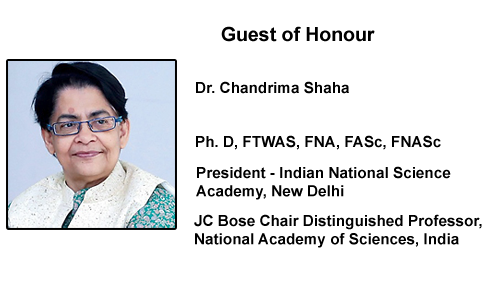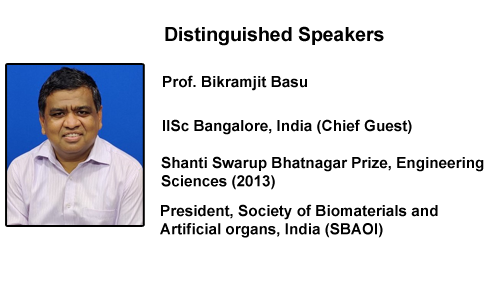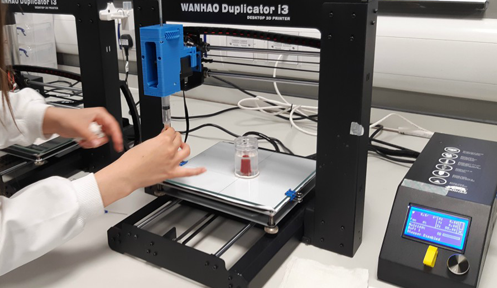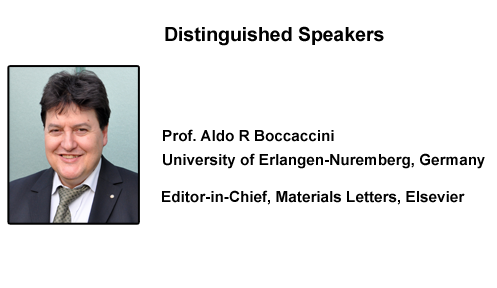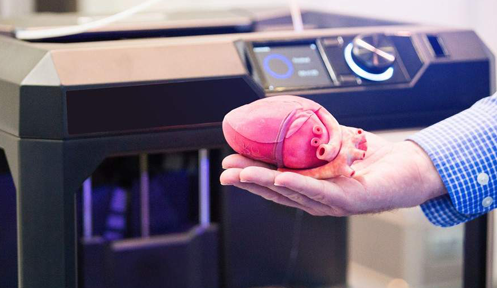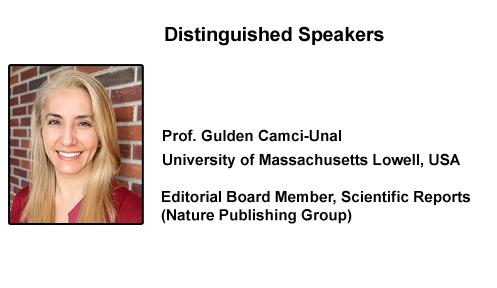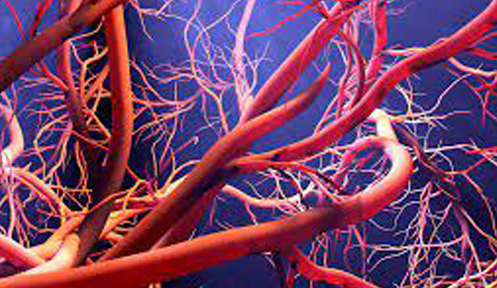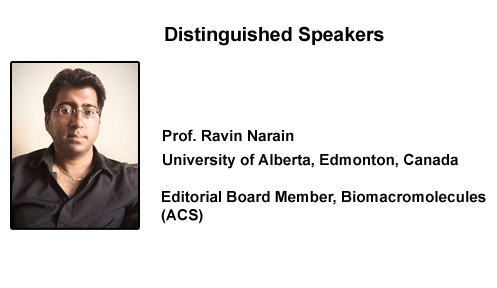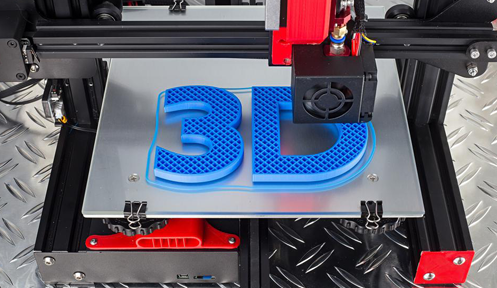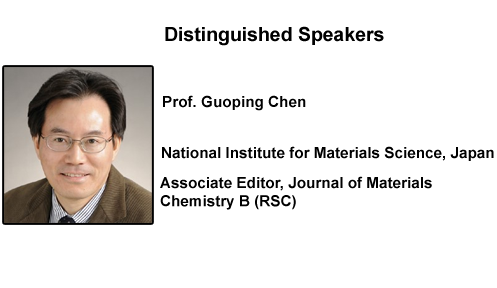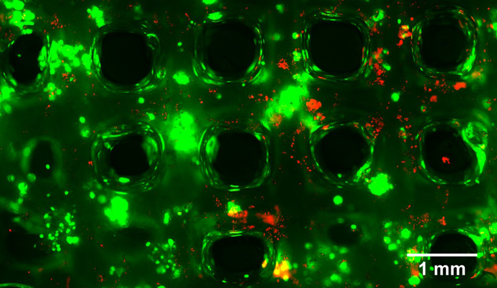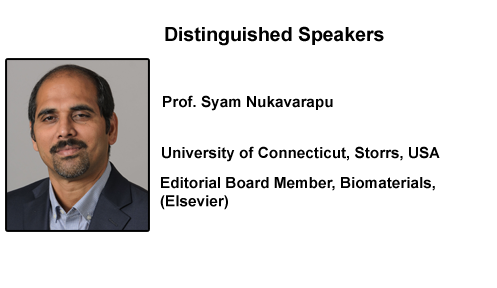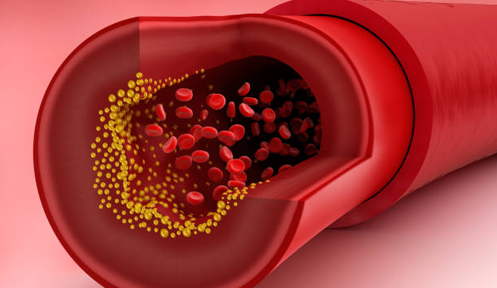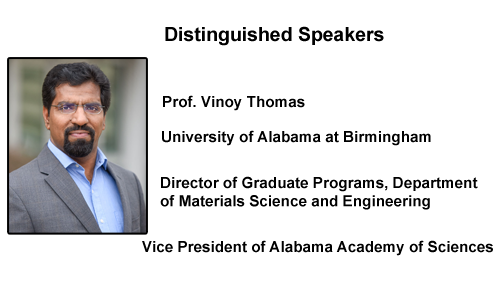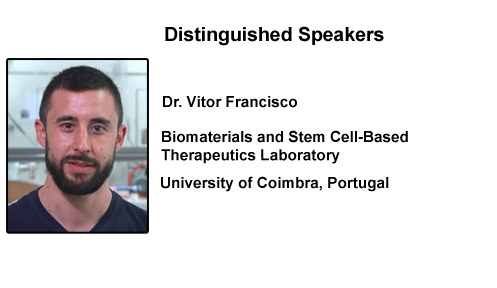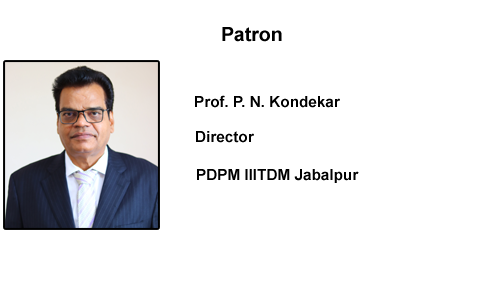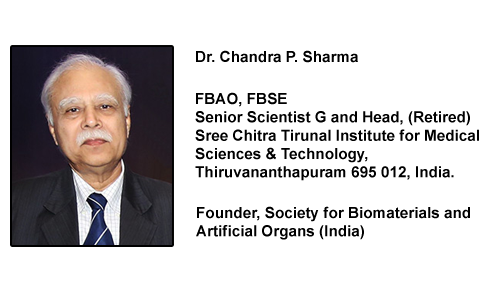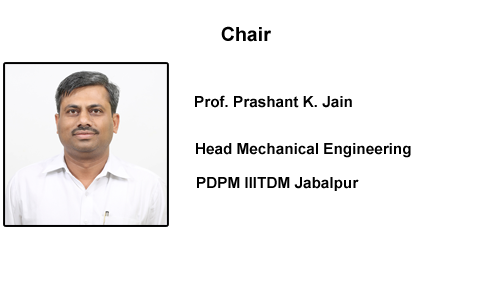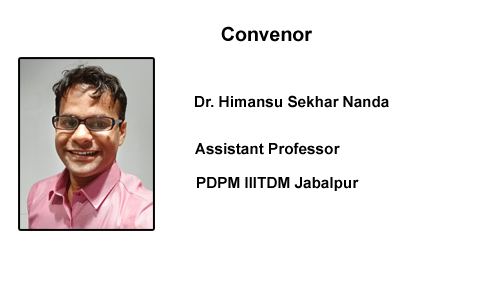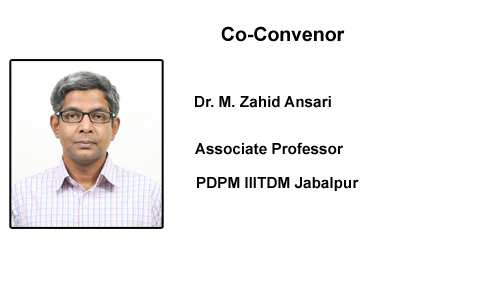Wellcome to an International Symposium on Emerging Materials for Biomedical Engineering
Distinguished Speakers
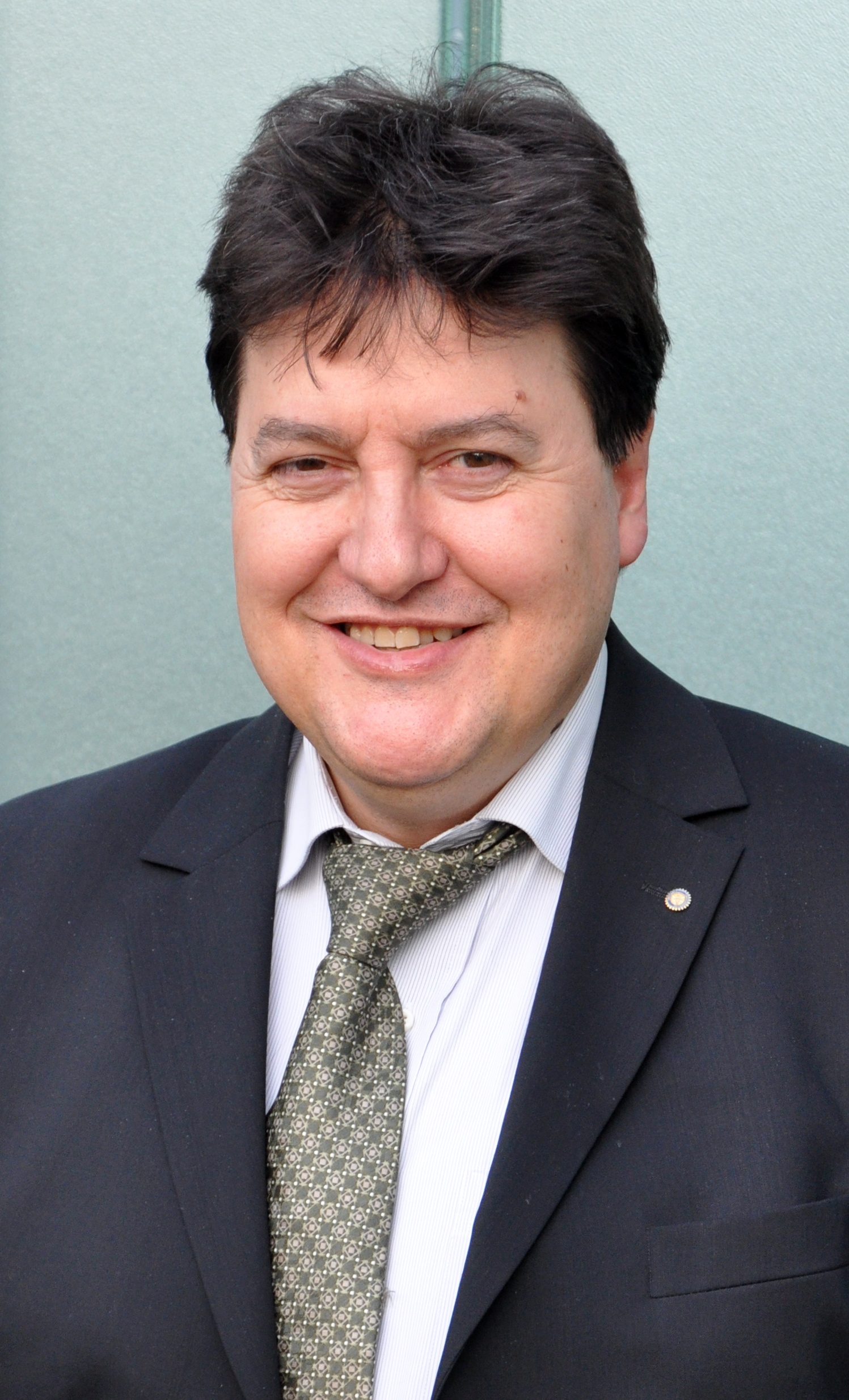
Prof. Aldo R Boccaccini, University of Erlangen-Nuremberg, Germany
Editor-in-Chief, Materials Letters, Elsevier
Bio: Prof. Dr.-Ing. habil. Aldo R. Boccaccini is Professor of Biomaterials and Head of the Institute of Biomaterials at the Department of Materials Science and Engineering, University of Erlangen-Nuremberg, Germany.Prior to this appointment, he was Professor of Materials Science and Engineering at Imperial College London, UK (2000-2009).
He has remained Visiting Professor of Materials at Imperial College London. The research activities of Prof. Boccaccini are in the broad area of glasses, ceramics and polymer/glass composites for biomedical, functional and/or structural applications.
Prof. Boccaccini has also developed the electrophoretic deposition technique for production of nanostructured materials and composites with defined surface topography with potential use in the biomedical field. He is the author or co-author of more than 800 scientific papers and 15 book chapters. Boccaccini is Fellow of the Institute of Materials, Minerals and Mining (UK), the American Ceramic Society and the Society of Glass Technology (UK).
He is the Editor-in-Chief of the journal “Materials Letters” (Elsevier) and serves in the editorial board of several recognized international journals including Journal of Materials Science, J. Tissue Engineering and Regenerative Medicine, International Materials Review, Plos One, Scientific Reports, J. Biomaterials Applications, Advanced Engineering Materials, Advances in Applied Ceramics, and J. Mater. Processing Technology. He is the founding editor and first Editor-in-Chief of the Open Access journal “Biomedical Glasses”. Boccaccini has been member of the organizing committee of numerous international conferences and he is the founder of the International Conferences Series on Electrophoretic Deposition (sponsored by Engineering Conferences International) having served as the Chairman of the 6 conferences of the series held so far in Canada (2002), Italy (2005), Japan (2008), Mexico (2011), Austria (2014), South Korea (2017). He is an elected member of the World Academy of Ceramics, the National Academy of Engineering and Applied Sciences of Germany and the Council of the European Society for Biomaterials.
Title: Bioactive glasses meet biofabrication: new approaches for tissue engineering
Abstract: Bioactive glasses, developed for the first time 50 years ago, are the first man-made materials capable to
bond to bone and soft tissues [1]. Traditional applications of BGs are as bone substituting materials, for
example bone defect filler, small size implants and as coatings for orthopedic applications. These
applications were expanded later to fabricate scaffolds for the bone tissue engineering field. More
recently, applications of BGs in soft tissue engineering have been emerging, including wound healing,
nerve and muscle repair. In such applications the biochemical interactions occurring at the BG-tissue
interface are relevant, which result in the controlled release of biologically active ions (BG dissolution
products) to activate specific cellular pathways [2]. Selected metal ions released from BGs have been
shown to induce angiogenic effect, e.g. in adequate concentrations they enhance vascular endothelial
growth factor release from stem cells, a very important property for tissue regeneration. Such angiogenic
effects of BGs will be discussed showing results on different scaffold types based on BGs. Moreover, cell
culture studies to characterize the variation of ion concentration (BG dissolution) in the medium and
resultant time dependent effects on stem cells will be presented. Such functionality of BGs is important to
assess comprehensively the biological performance of BGs with implication for clinical translation.
In this context, applications of BGs in the field of 3D bioprinting (biofabrication) are emerging. Here
specially sol-gel derived mesoporous BG nanoparticles are being considered as second phase in cell laden
hydrogels, thus expanding the applications of BGs in TE. In the second part of the presentation, the
progress in the development and characterization of TE scaffolds made purely from BGs or by combining
BGs and biopolymers, including their application in 3D bioprinting approaches, will be discussed.
Examples of such applications will be presented with focus on novel developments of hydrogel-bioactive
glass composites as innovative multimaterial bioinks for cell encapsulation and for biofabrication of cell
laden scaffolds of increasing complexity [3]. The author’s views on the challenges and opportunities for
further research in the field will be presented.
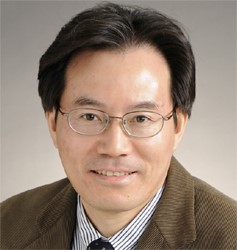
Prof. Guoping Chen, National Institute for Materials Science, Japan
Associate Editor of Journal of Materials Chemistry B (RSC)
Bio:Prof. Guoping Chen received his Ph.D. from Kyoto University in 1997 majoring in Biomaterials and did postdoctoral research until 2000. He became Researcher in 2000 and Senior Researcher in 2003 at Tissue Engineering Research Center, National Institute for Advanced Industrial Science and Technology, Japan. He moved to Biomaterials Center, National Institute for Materials Science (NIMS) as Senior Researcher in 2004 and was promoted to Group Leader in January, 2007. He was Principal Investigator and Unit Director of Tissue Regeneration Materials Unit from April, 2011 to March, 2015; Principal Investigator, Field Coordinator and Unit Director of International Center for Materials Nanoarchitectonics, NIMS from April, 2015 to March, 2017. He is also Professor of Department of Materials Science and Engineering, Graduate School of Pure and Applied Science, University of Tsukuba, Japan. His research interests include tissue engineering, polymeric porous scaffolds, nanobiomaterials, biomimetic biomaterials, nano/micro-patterning and surface modification. He has authored more than 280 publications and holds 18 issued patents. He has given more than 140 invited lectures at conferences. He is Associate Editor of Journal of Materials Chemistry B; Editorial Boards of Journal of Bioactive and Compatible Polymers, Tissue Engineering, Journal of Tissue Engineering and Regenerative Medicine, Regenerative Biomaterials and Biomedical Materials; Advisory Board of Biomaterials Science. He also serves as Member-at-Large of Tissue Engineering and Regenerative Medicine International Society’s Asian-Pacific Chapter and Director of Japanese Society for Biomaterials. He has been selected Fellow of the Royal Society of Chemistry in 2015 and the American Institute for Medical and Biological Engineering (AIMBE) in 2017.
Title: Porous Polymer Scaffolds and Biomimetic Matrices for Tissue Engineering
Abstract: Porous scaffolds play an important role in controlling cell functions to guide tissue
regeneration. Biodegradable synthetic polymers such as PLLA and PLGA and naturally
derived polymers such as collagen and gelatin have been the most frequently used
biodegradable polymers for applications in tissue engineering and regenerative medicine
(TERM). Cell-derived extracellular matrices have also been frequently used to prepare
biomimetic scaffolds. We have developed a few types of porous scaffolds by using
biodegradable polymers and extracellular matrices for TERM. The first type is porous
scaffolds prepared by using ice particulates as porogen materials to control porous structures.
This type of scaffolds had well interconnected pore structures and micropatterned structures.
The second type is hybrid scaffolds of synthetic polymers and naturally-derived polymers.
Collagen sponge or microsponges were incorporated in the pores or openings of mechanically
strong PLLA or PLGA porous skeletons to form the hybrid structures. The PLLA or PLGA
skeletons provided high mechanical strength, while the collagen sponge and mircosponges
facilitated cell seeding and distribution. The third type is biomimetic ECM scaffolds prepared
from cultured cells. Composition of the ECM scaffolds was dependent on the cell type and
cell phenotype that were used to prepare the scaffolds. These porous scaffolds were used for
3D culture of fibroblasts, chondrocytes and bone marrow-derived MSCs for tissue
engineering of dermal tissue, muscle, cartilage and bone. The fourth type is photothermal
scaffolds prepared by hybridization of photothermal agents such as gold nanoparticles and
black phosphorus nanosheets with biodegradable polymers. The photothermal scaffolds were
used for both photothermal ablation of breast cancer cells and breast tissue engineering.
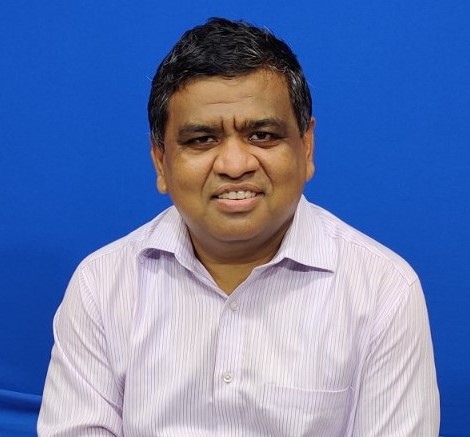
Prof. Bikramjit Basu, Materials Research Centre (MRC), IISc Bangalore, India
Shanti Swarup Bhatnagar Prize, Engineering Sciences (2013)
Editorial Board Member, Materials Sciences and Engineering C, Elsevier
Bio: Prof. Bikramjit Basu is currently a Professor at the Materials Research Center, and holds Associate Faculty position at Center for Biosystems Science and Engineering, Indian Institute of Science (IISc), Bangalore. He is appointed as Visiting Professor at University of Manchester, UK (2018-2023) and at the European Centre for Functional and Surface Functionalized Glass, Alexander Dubček University of Trenčín, Slovakia (2020-2021). After his undergraduate and postgraduate degree in Metallurgical Engineering from NIT Durgapur (1995) and IISc (1997) respectively, he earned his PhD in the area of Engineering Ceramics at Katholieke Universiteit Leuven, Belgium in March, 2001. Following a brief post-doctoral stint at University of California; he served as a faculty in Materials Science and Engineering at IIT Kanpur (2001-2011) and moved to IISc in May, 2011. Prof. Basu’s contributions in Engineering Science have been globally recognised. He received India’s most coveted science and technology award, Shanti Swarup Bhatnagar Prize in 2013 for his significant contributions to the field of Biomaterials Science. A Chartered Engineer of the UK, he is an elected Fellow of the International Union of Societies for Biomaterials Science and Engineering (2020), Fellow of the Indian Academy of Sciences (2020), Fellow of the American Ceramic Society (2019), American Institute of Medical and Biological Engineering (2017), Institute of Materials, Minerals & Mining, UK (2017), National Academy of Medical Sciences, India (2017), Indian National Academy of Engineering (2015), Society for Biomaterials and Artificial Organs (2014) and National Academy of Sciences, India (2013). He remains the only Indian from India to receive the ‘Robert L. Coble Award for Young Scholars’, a prize named after an MIT Professor, from the American Ceramic Society (2008). Prof. Bikramjit’s current research integrates biomaterials science and bioengineering approaches to address human healthcare issues. Professor Basu is serving as an editorial board member of Biomaterials (Elsevier) and Materials Science and Engineering C (Elsevier).
Title: Biomaterials and Implants in India: Current Status and Recommendations
Abstract: Medical devices are a major part of healthcare costs. Nearly 80 percent of devices come from outside the country: the USA, Germany, France, Singapore, China and the Netherlands, and healthcare costs are not affordable to many Indians. Also, a large number of patients come to India for treatment from the Middle East, Africa and neighbouring countries (Bangladesh, Sri Lanka, Nepal, Bhutan etc.). The translational research ecosystem in India has evolved to address this chain of high healthcare costs and unmet clinical needs. A key challenge for innovation is the manufacturing of affordable biomedical devices without compromising on quality.
Against the above perspective, this talk will describe a few case studies illustrating the most recent research findings from our group and other leading research groups based in India, to illustrate how to take labscale research to biomedical device development through collaborative efforts of Academia and National laboratories with intensive-interactive inputs from Clinicians and Industries. In particular, the translational research on acetabular liner, dental implants and the multicentric pilot studies using patient-specific bone flaps for cranioplasty surgery will be particularly highlighted.
Towards the end of the presentation, I will discuss a set of policy-related recommendations for the accelerated growth of biomaterials science and implants in the next decade and beyond. The recommendations discussed should help to establish India as a global market leader for a new generation of bioimplants, whose predictive clinical performance would be closely tracked by “digital twins”. It is the speaker’s vision that such a discussion would not only encourage young researchers to be passionate about understanding the current challenges, and those of the end-user, but also inspire them to form strong collaborations for adaptive problem solving, thereby making significant contributions to the field. Given the right support, the key recommendations of the speaker can be highly transformative to the field and are ideas that can carry forward both people's wellbeing and the nation's economy in their energy and momentum.
Reference: Bikramjit Basu, “Biomaterials Science and Biomedical Implants: Status, Challenges and Recommendations” Indian National Science Academy-Springer monograph, 2020 (https://link.springer.com/book/10.1007/978-981-15-6918-0).
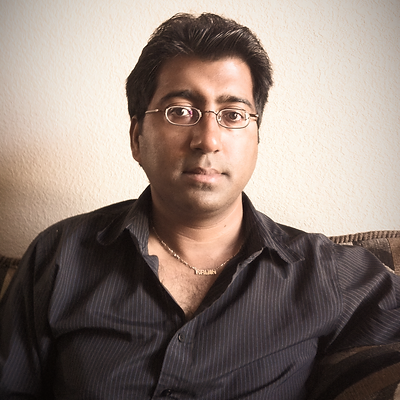
Prof. Ravin Narain, University of Alberta, Edmonton, Canada
Editorial Board Member, Biomacromolecules (ACS)
Bio: Ravin Narain, PhD, P.Eng, FRSC is a Professor in the Department of Chemical and Materials
Engineering, University of Alberta, Canada. Prof. Narain has made significant contributions to
research on the design, fabrication, and characterization of novel carbohydrate based materials
(glycopolymers, hydrogels and nanomaterials) for a wide range of applications. His research has
also covered biomaterials, nanomedicine and regenerative medicine, with an emphasis on
developing advanced materials as cancer therapeutics, anti-fouling and anti-microbial uses, and
cell/tissue engineering advances. He has published over 180 articles in peer-reviewed and high
impact journals and has edited several books namely Engineered Carbohydrate-Based Materials
for Biomedical Applications (Wiley), Chemistry of Bioconjugates (Wiley), Glycopolymers:
Synthesis and Applications (Smithers & Rapra), and Polymers and Nanomaterials for Gene
Therapy (Woodhead Publishing & Elsevier). He was section editor for the second edition of the
book – Comprehensive Glycoscience (Elsevier). He is also on the Editorial Board for Frontiers in
Chemistry (Polymer Chemistry), Polymer Chemistry (RSC), Biomacromolecules (ACS) and
Polymers (MDPI). He was the recipient for a Distinguished Visiting Scientist Award from CSIRO
(Manufacturing), Melbourne, Australia (2017-2018).
Title: Versatile Nanomedicines and Hydrogels for Biomedical
Applications
Abstract: Recent developments in polymer science and organic chemistry have allowed the
molecular design, engineering and fabrication of advanced and tailor-made materials for a wide
range of applications. In particular, the reversible addition-fragmentation chain transfer
polymerization has shown to be an excellent method to access well-defined polymers containing
new functionalities for applications in drug and gene delivery, advanced biomaterials and
cell/tissue engineering. This talk will focus on two aspects of current research in my laboratory.
The first part of the lecture will focus on the molecular engineering of polymers for the delivery of
cancer drugs and nucleic acid. We have recently shown that we can minimize the cationic groups
in the copolymers by various approaches without compromising the stability, toxicity and gene
knock-down efficiency of the polyplexes. In addition, we have also developed new polymer
systems and nanogels for delivery of radiopharmaceuticals. The second part of the lecture will
focus on biocompatible and non-toxic hydrogels via dynamic covalent chemistry. Hydrogels
prepared from conventional approaches with covalent interactions seemed unable to fulfil some
of the requirements of future medicine. Therefore, in recent years, more attention has focused on
stimuli-responsive and self-healing hydrogel-based materials. The self-healing ability can offer
better performance of the hydrogels, while the sensitivity to internal/external stimuli, such as
temperature, pH, light and biomolecules enables the necessary environment for cell or tissue
growth within the scaffold or be used for the controlled release of therapeutic agents. Usually,
non-covalent interactions (e.g. host-guest complexations and hydrogen bonding) and dynamic
covalent chemistry (e.g. Schiff base, disulfide, hydrazone, Diels-Alder reaction, and boronic ester)
are the most common ways to prepare self-healing hydrogels, and the latter, appears more
convenient to accomplish the simultaneous stimuli-responsiveness via dissociation of the
dynamic covalent bonds. I will highlight the easy fabrication of self-healing and responsive
hydrogels using polymer entities containing boronic esters with various polymers containing diols
to generate materials with tunable properties.
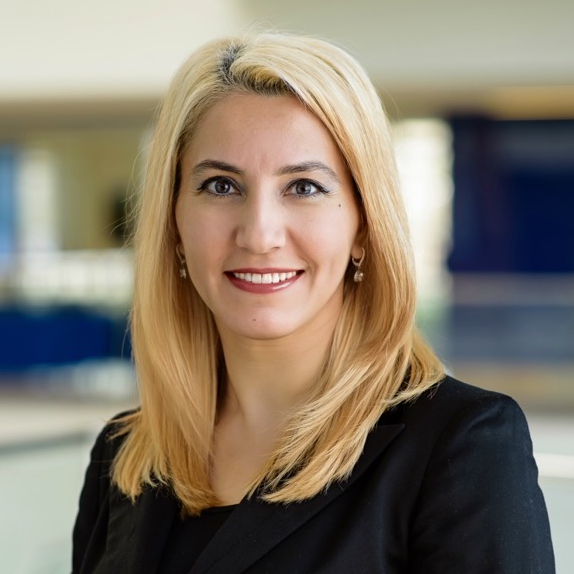
Prof. Gulden Camci-Unal, University of Massachusetts Lowell, USA
Editorial Board member of Scientific Reports (Nature Publishing Group) and PloS One
Bio: Dr. Gulden Camci-Unal is an Assistant Professor in the Department of Chemical Engineering at the University of Massachusetts Lowell. Her current research interests include design and implementation of engineered biomaterials for regeneration of tissues, unconventional materials and medical devices for personalized medicine, and low-cost point of care diagnostics. Her research has been supported by the NIH, NSF, US Army, CDMRP, AHA, and Phase 1 and Phase 2 SBIR and STTR grants.
Dr. Camci-Unal’s research and teaching achievements include various awards such as the Robert and Gail Ward Endowed Professorship (2020, 2021), University of Massachusetts Lowell Teaching Excellence Award, Iowa State University Teaching Excellence Award, Runner-Up for the Massachusetts Medical Device Development Center (M2D2) $200K Challenge (2019, 2020), Wakonse Fellowship, Chevron-Phillips Award, Procter&Gamble Fellowship, NSF ADVANCE Travel Award, and finalist for BioFlux Innovation Award.
Her research has resulted in 83+ papers, 80+ conference abstracts, and 10+ patent applications so far. Her work has been published in various high impact journals such as Trends in Biotechnology, Advanced Materials, Nature Asia Materials, JACS, Biomaterials, Lab on a Chip, Soft Matter, and Tissue Engineering. She is an Editorial Board member of Scientific Reports (Nature Publishing Group), PLoS One, Gels, Regenerative Engineering and Translational Medicine, International Journal of Bioprinting, Micromachines, and Engineered Regeneration.
Title: Unconventional Biomaterials to Improve Human Health
Abstract: Regeneration of tissues damaged due to disease, trauma, degeneration, and aging represents a major medical need. Although surgical replacement can be performed to address this issue, insufficient number of donors limits the applicability of the approach. There is an unmet demand for development of tissue replacements. My work at the interface of biomaterials and biomedical engineering has made important contributions in generation of engineered biomaterial platforms through my multidisciplinary research background. To achieve my research goals, I use diverse tools from chemistry, cell biology, materials science, engineering, and medicine. In this seminar, I will talk about the functional biomaterials that we developed using unconventional approaches to generate tissue-mimetics for clinical applications. We developed multicellular and compartmentalized scaffolds for regenerative engineering, hydrogel-based platforms for personalized medicine, bioactive scaffolds for template-guided biomineralization, oxygen-generating biomaterials for tissue repair, micro/nanoparticle-reinforced hydrogels and origami-inspired approaches for bone tissue engineering, and hydrogel-based stem cell delivery approaches. I will also talk about my lab’s expertise on developing point of care (POC) diagnostic platforms for detection of pathogenic diseases (viral and bacterial), health conditions, forensic applications, and testing for environmental reagents. To overcome the limitations with the conventional methods, we develop rapid, portable, and reliable platforms for POC diagnostics. For example, we developed a rapid and simple test for detection of the Covid-19 virus from bodily fluids in only 5 min. My lab’s research projects cover a broad range of applications including understanding fundamental biology to developing disease models for personalized medicine, tissue repair and regeneration, and rapid POC diagnostics. The overarching goal of my research is to improve human health and quality of life.
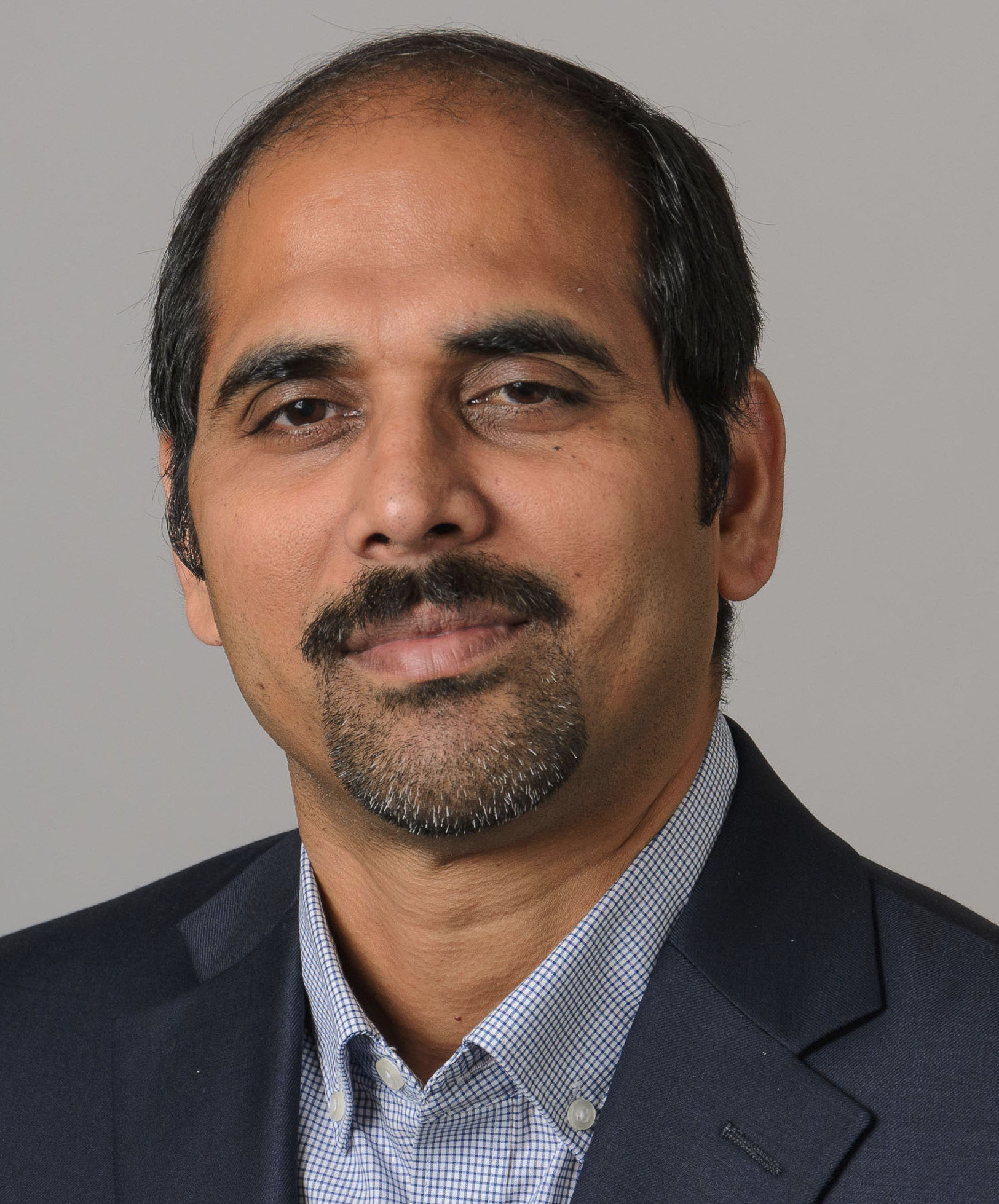
Prof. Syam Nukavarapu, University of Connecticut, Storrs, USA
Editorial Board, Biomaterials, (Elsevier)
Bio: Syam Nukavarapu, PhD, is an Associate Professor of Biomedical Engineering at the University of Connecticut (UConn). He holds joint appointments in the department of Materials Science and Engineering, UConn, and the Department of Orthopaedic Surgery, UConn Health. Dr. Nukavarapu received PhD from Indian Institute of Science, Bangalore, and held post-doctoral positions at Lehigh University, PA and University of Virginia, VA. He leads Tissue Engineering Science and Technology Laboratory (TEST Lab) at UConn, and his research interests include biomaterials, bio-fabrication, and tissue engineering.
Dr. Nukavarapu has made major contributions in the design and development of novel biomaterials and engineered graft systems to study and understand biomaterial–cell interactions. His laboratory is currently developing bioprinted structures with local control over stem cell fate and function for tissue, tissue-tissue interface engineering. Dr. Nukavarapu has authored over eighty original articles, book chapters, and invited opinion article/reviews. He edited two books and serves on the editorial boards of major journals in the field, including Biomaterials, Bioactive Materials and Tissue Engineering.
Title: Biomaterials and Biofabrication for Tissue Engineering
Abstract: From simple to complex tissue regeneration, the field of tissue engineering has made significant progress in the last two decades. The goal of our research program is developing innovative biomaterial systems and biofabrication methods to closely mimic native extracellular matrix in structure, hierarchy and function. In this talk, I will share some of the recent work carried out in my Tissue Engineering Science and Technology Laboratory (TEST Lab) in the area of engineered biomaterials and structures. The first part of my presentation will focus on the synthesis of a silica biomaterial/ matrix that was formed via thermal fusion of amorphous silica fibers. The developed matrices are found to be biodegradable, porous and closely resemble the native extracellular matrix structure and water absorption. This material platform presents beneficial hydrophilic properties of hydrogels and other polymeric/ceramic-based scaffold systems while minimizing the potential drawbacks of those systems such as difficulties in sterilization and handling and rapid loss of mechanical properties due to swelling or degradation. Latter part of my presentation will focus on the development of bio-inspired zonal structured matrices for interfacial engineering. For this study, we bioprinted complex scaffold systems in various configurations to support osteochondral tissue zonal structure and to closely mimic the bone-cartilage interface. Furthermore, a novel bioprinting method was developed to selectively introduce cells into desired scaffold zones of the zonal/gradient scaffolds via concurrent printing of a cell-laden hydrogel within the porous template. The presentation will also include some of the recent findings related to tissue-derived biomaterials and bio-inks, the development and the findings of cell spheroid technology and controlling spheroid – spheroid and spheroid – matrix interactions for tissue engineering.
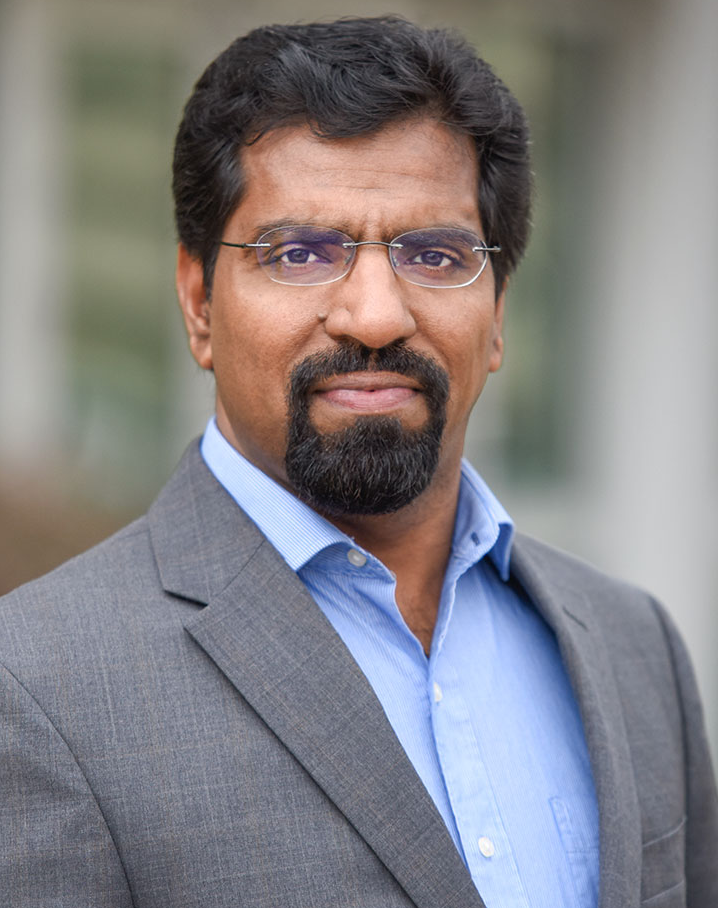
Prof. Vinoy Thomas, University of Alabama at Birmingham
Director of Graduate Programs, Department of Materials Science and Engineering
Vice President of Alabama Academy of Sciences
Bio:
Vinoy Thomas is an Associate Professor and Graduate Program Director at the Department
of Materials Science and Engineering, University of Alabama at Birmingham, USA. He holds
secondary appointments in other UAB Departments of Physics (College of Arts and
Sciences), Biomedical Engineering (School of Medicine-Engineering), and Environmental
Health Sciences (School of Public Health) He is an Associate Scientist at the Centre for
Nanoscale Materials and Bio- integration (CNMB). After his PhD in Biomaterials &
Technology Dr Thomas completed postdoctoral training at University of Jena, Germany, and
at the National Institute of Standards & Technology (NIST) USA, [as NRC Fellow of the US
National Academy of Sciences, (NAS)]. His research focuses on biomaterials processing-
property relationships, nanomaterials for tissue engineering, plasma processing, and
nanodiamonds for joint-implants. He has more than 100 publications (h= 32) and several
IP/Patents published to his credits. Dr Thomas is a recipient of UAB provost award for
Faculty Excellence and UAB Graduate School Dean’s award for Excellent Mentorship. He is
a life-member/member of many professional societies and Vice-president of the Alabama
Academy of Sciences (AAS), Chairman of US chapter of SBAOI and co-organized many
symposiums for TMS (The society for Minerals, Metals and Materials). He serves as editorial
board member of several scientific journals in his area of research and Guest co-editor for
special issues (JOM (springer), COBME (Elsevier), CNANO (Bentham sci)). Recently he co-
edited a Book on Tissue Engineering- Current Status and Challenges (Elsevier).
Title: Plasma engineering of biomaterials and scaffolds
Abstract: Polymers and Healthcare Materials/Devices group explore Chemistry of Polymers
to Biomaterials Science and Nanotechnology, development and characterization of
nanostructured surfaces of implant/materials and 3D fabrication of extracellular mimicking
tissue scaffolds for soft-tissue engineering and cell-materials interactions. As part of the
development of “hybrid nano-biomaterials” for tissue engineering, we have
fabricated/studied polymer/protein tubular scaffolds for vascular applications and laid the
groundwork for the proposed research by developing fibro-porous grafts and plasma
modification for better biocompatibility and biointegration, functionally-graded graft bone
grafts materials with hydroxyapatite, microwave plasma synthesised nanodiamond coating
on orthopaedic and dental implants for wear resistance, pulsed laser coating of hydroxyl
apatite, electrophoretic deposition of calcium minerals for better bio integration on both bone
implants and scaffolds for bone tissue engineering The cold plasma technology for
selectively tune the surface of implants. His group created O-rich, N- rich and NO- rich
super hydrophilic surface and Organic super hydrophobic surface with graft nanostructures
and plasmonic materials integrated 3D printed scaffolds. We will cover in and around these
topics.
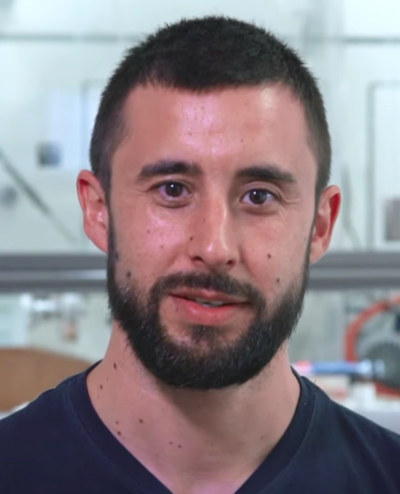
Dr. Vitor Francisco,Biomaterials and Stem Cell-Based Therapeutics Laboratory
University of Coimbra, Portugal
Bio: Vitor Francisco graduated in Chemistry from University of Coimbra (Portugal) in 2008 and completed a PhD degree in Physical Chemistry from the University of Santiago de Compostela (Spain) in 2014 where he contributed to the field of drug delivery using supramolecular chemistry. Since obtaining his PhD degree, he joined the group of Lino Ferreira, ERC and ERA Chair grantee, at Center for Innovative Biomedicine and Biotechnology. He is currently focusing on controlled delivery of drugs mainly for ageing-related diseases.
Title: A combinatorial library of light responsive nanoparticles for wound healing
Abstract: Impaired wound healing and its medical complications remain one of the most prevalent and economically burdensome healthcare issues in the world. RNA-based therapies have emerged recently as promising drugs for skin regeneration, with distinct advantages over conventional drug therapies such as small molecules or other biomolecules, such as specificity, potency, number of accessible targets, species cross-reactivity, manufacturing, etc. However, several obstacles need to be addressed before the clinical translation of RNA-based therapeutics. In particular, the design of formulations that enable their delivery to a target cell in the skin reducing potential off-target effects and simultaneously increase their efficacy in the intracellular delivery. The hypothesis of the current work was that biocompatible light-activatable nanoparticles (NPs) allowing precise control of the timing and spatial release of the RNA molecules could accelerate the translation of these therapies.
Our experimental results indicate that we can produce a library of light-activatable NPs (more than 300 NPs) that dissociate at different rates once activated by UV or a blue laser. We have performed high-throughput screenings in reporter cells to identify formulations that were rapidly taken up by cells and deliver efficiently siRNA (more effectively than the commercial transfection agent lipofectamine RNAiMAX). We have identified candidates that were further characterized in secondary tests regarding their specificity to skin cells (some NPs were more internalized by a specific type of cell than other), endolysosomal escape and functional studies before and after light activation. Moreover, we have confirmed the advantages of one of the candidate formulations in a wound healing animal model, for the delivery of a skin regenerative miRNA identified recently by us. In conclusion, we have developed a powerful platform for the delivery of RNA-based therapeutics delivery both in vitro and in vivo.

